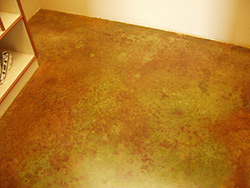 |
||||||||||
| March 17, 2004
In This Issue of The Acid Staining Newsletter Pointillism on Concrete and Other Topics Since starting this Newsletter series I have received over 20 suggestions from readers on topics they would like to see covered. Thank you all for your responses! For those of you who asked about problems of efflorescence on the slab; this is something I am glad to say I have not had to learn much about, since it is rarely seen in New Mexico. We have had it appear over our stain on dark floors only twice. When we switched from a water-based acrylic to a solvent-based acrylic, it disappeared. The solvent sealer was not something we planned to use, but it seemed to "eat up" the white powder on the surface, which was a great relief. |
||||||||||
| At the World of Concrete I met George Lacker, a concrete artist from Plantation, Florida. He told me that he could get some fine, dotted effects on acid stain by soaking ground-up corncobs in stain and sprinkling them across the surface. The corncob material is sold as pet litter or bedding for animal's cages. It is nicely absorbent. I had been hoping to break our stain colors up a bit while avoiding or counteracting the flow marks which often appear as the stain runs to low spots in the slab. When we returned home from the WOC we had a small job staining a utility room and kitchen in Santa Fe. Rae and I decided to surprise the client with this new technique. We first stained the slab a vivid green (QC Patina Stain's "Jade Green"). While it was still wet, we sprinkled corncob litter and small wood chips (which had been soaked in a bucket of Scofield's "Antique Amber" color) across the floor. After removing the litter and cleaning the floor, we found that the colors contrasted too vividly. Our client was, indeed, surprised. She requested that we tone it down a bit. We then sprayed the floors with more of the light brown Antique Amber in a pump-up sprayer. This settled the colors in and integrated them well. Our client was happy and so were we. Here are two pictures of the results. I think the effect is enhanced by the fact that the floor was saw cut into sections two feet on a side. The geometry of the saw cuts contrasts nicely with the amorphous blobby look of the groups of dots. We taught this trick in our subsequent seminar and the students had some fun with it. We are already thinking of ways in which we can make the effect a bit more subtle. |
||||||||||
 |
||||||||||
 |
||||||||||
 |
||||||||||
|
OUR NEXT SEMINAR IS AROUND THE CORNER! My first seminar of 2004 was a huge success. We had a wonderful time, made new friends and did lots of learning. I am very excited about my upcoming "Advanced" seminar in April. We are going to explore a variety of artistic techniques and increase your knowledge of acid staining. So, if you're ready to take your acid staining to the next level, click here for more info about this upcoming seminar. Questions or comments about my newsletter? |
||||||||||
|
|
||||||||||
